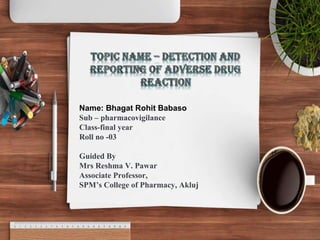
Monitoring adverse drug reactions
- 1. Name: Bhagat Rohit Babaso Sub – pharmacovigilance Class-final year Roll no -03 Guided By Mrs Reshma V. Pawar Associate Professor, SPM’s College of Pharmacy, Akluj
- 2. 2 Patients susceptible to adverse drug reactions must be properly identified and monitored. Methods of detection of ADR:- 1. Pre-marketing safety Evaluation 2. Post marketing surveillance 3. Causality assessment 4. Communicating ADR 5. Postal Survey Method 6. Dechallenge/Rechallenge Detection of ADR
- 3. Pre-marketing safety Evaluation > Animal studies -:Specific animal studies for carcinogenicity, teratogenicity and mutagenicity easily accessible > Human studies:- Pre-marketing safety Evaluation > Phase 0: microdosing study (max 100mg) > Phase 1: in this low dose on low population are study > Phase 2: in this efficacy and safety of drug study. Number of patients are more than phase 1 > phase 3: in this phase safety Evaluation and tolerability are studied . In this patient are in large amounts > Specific groups are studied 1) elderly patients . 2) compromised patients 3
- 4. Post marketing surveillance > Spontaneous Report : reports of ADR by health care practitioner such as physicians ,nurses, pharmacist > Clinical study: > A) cohort studies – Patient exposed to Particular drug should be monitored and compared to unexposed group. > B) Case control studies: a)Person affected due to adverse event being studied should be recognised and Each case should be compared to Several disease free control patients. > Meta-analysis of clinical study > Published case reports : various case reports studies and ADR detected. 4
- 5. Causality assessment > Following knowledge of ADR to suspected medicine or other > In case of ADR suspected Then assessment starts with Collection of relevant Data Related to patients demographic such as Time of action and duration of Action , Treatment of react , outcome and reports. Communicating of ADR: Following knowledge About rational and Safe use of medicines are provided > Basis training of health professionals > Conducting constant education Programs for health professionals. > Counselling the patient. 5
- 6. > It is main used for monitoring ADR of new drugs i.e.within1 to 2 years After > Drug has been launched . Dechallenge/Rechallenge: > Drug causing ADR Withdraw, if does not found any ADR then called positive Dechallenge > If ADR found , then withdraw the drug ,again given to the drug to check ADR is called Rechallenge 6 Postal Survey Method
- 7. Reporting of ADR > Reporting of ADR is One of the most important parameter Of medical treatment > ADR involves the receipt, Data entering, assessment,adverse event Data and documentation. > Spontaneous reporting of suspected ADR, a regional or country wide system for reporting is currently major source of information in pharmacovigilance . Who should Report ADR > Healthcare professionals > Nurses > Pharmacist > Marketing authorisation holders 7
- 8. 8 What to Report > All serious reactions and interaction > Poisoning due to traditional or herbal medicine > All suspected ADR related to Drug- drug, drug – food Interaction. > All ADR As a result of Prescription and Non-Prescription medicinal products > All suspected ADR Irrespective to Product information delivered by Company . Where to Report : > Peripheral pharmacovigilance centre (city wise ) > Regional pharmacovigilance centre > Central pharmacovigilance centre
- 9. Sections to validate Individual case safety Report > 1) Patient identification > 2)Reporter identification > 3) Suspected ADRs > 4) suspected medicine 1. patient identification > The Name, initials or number of the patient in a hospital, name of the medical institution, dispensary, clinic or pharmacy are to be indicated or recorded in the report. > Age at a time of reaction , sex, weight, should be indicated. 2. Reporter identification > Name of the Reporter > Qualification > Contact details And address are indicated . 9
- 10. 10 > Name of the suspected drug (s): Trade name should preferably be used, if trade name is not available, generic name may be used. Strength of the drug (s) should also be stated > Dosage, frequency and route of administration: should be clearly mentioned. > Therapy date: The dates of starting and end of the administration of each drug should be stated . > Batch number and Expiry date: should be mentioned. Suspected ADR’s: > Description of Reaction. > Seriousness of Reaction. > Date of start and stop of Reaction. > Laboratory tests and relevant Data. > Date of drug withdrawal / continuous of ADR. Suspected medicine
- 11. 11 1)Book of pharmacovigilance, Thakur publication Pvt.Ltd. First edition By Dr. Agnimitra Dinda , Monika saxena Page no- 26-32 Reference
- 12. 12 Thanks!